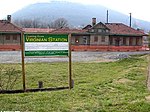Roanoke Star

The Roanoke Star, also known as the Mill Mountain Star, is the world's largest freestanding illuminated man-made star. It was constructed at the top of Mill Mountain in Roanoke, Virginia in 1949 by the local merchants association to draw publicity and trade to the city. The star was initially intended to be lit only during Christmas seasons, but was popular enough with the citizens of Roanoke that it is illuminated every night year-round. It stands 88.5 feet (27.0 m) tall and weighs 60,000 pounds (27,000 kg), rests 846 feet (258 m) above the city of Roanoke, and is visible for 60 miles (97 km) from the air. Its 2,000 feet (610 m) of neon tubing are typically lit entirely in white, but have the ability to shine solely in red (historically for tragic events), or in red, white, and blue (for patriotic holidays). The star has become a symbol of Roanoke and the source of its nickname "Star City of the South", and it along with its accompanying scenic overlook are popular tourist destinations in the area.
Excerpt from the Wikipedia article Roanoke Star (License: CC BY-SA 3.0, Authors, Images).Roanoke Star
Star Trail, Roanoke Morningside
Geographical coordinates (GPS) Address Nearby Places Show on map
Geographical coordinates (GPS)
| Latitude | Longitude |
|---|---|
| N 37.250833333333 ° | E -79.9325 ° |
Address
Star Trail
24014 Roanoke, Morningside
Virginia, United States
Open on Google Maps






